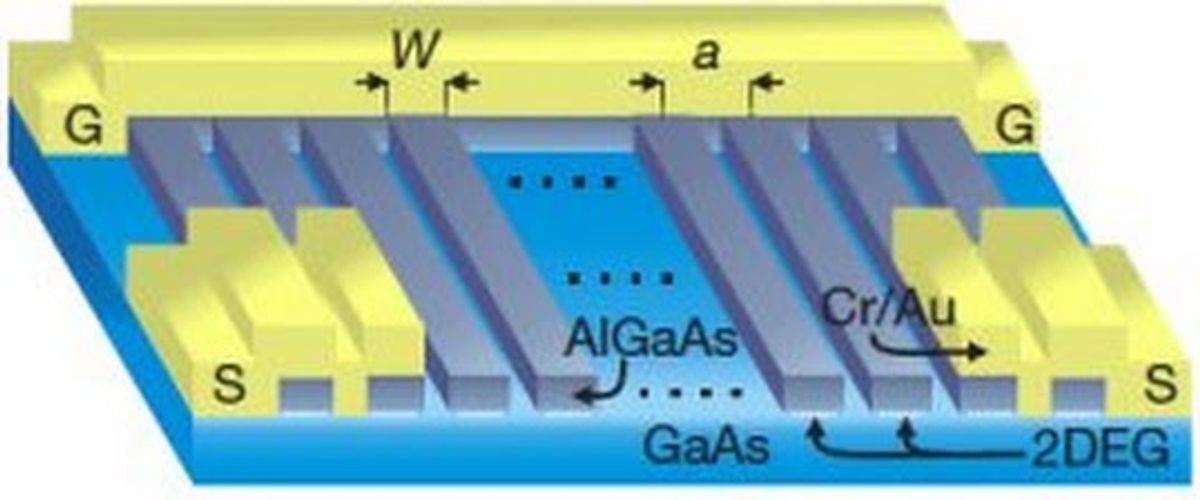A new metamaterial, built from two semiconducting layers, has been shown to have an unprecedented ability to refract light in the wrong direction.
When light moves from one medium to another, the change in speed causes it to bend or refract. The refractive power of any one material is measured by its index of refraction. For naturally occurring materials, this index of refraction is positive and typically has a value of 5 or less.
Metamaterials, which can be built in a range of ways by using, say nanoparticles or bent arrangements of wire, can bend light differently, exhibiting a property called negative refraction. They’ve been eyed for a range of applications, from invisibility cloaks to light manipulating devices that can beat the physical limitations of conventional materials.
Most metamaterials have been created with negative indices of refraction in the same rough range as naturally occurring materials (although they boast the opposite sign), says Donhee Ham at Harvard University. But, as Ham and his colleagues report today in Nature, there is a way to create "extraordinarily strong" negative refraction. The team built semiconductor devices with negative refractive indices as low as -700, a hundred times larger in magnitude than what’s seen in most negative index metamaterials, and, Ham suspects, the strongest yet seen. What's more, he says, the device can manipulate microwaves in area that’s about 1/10,000th the size of what’s needed for metamaterials that use wire-based devices like split ring antennas.
To accomplish this miniaturization feat, Ham's group at Harvard, along with Vladimir Umansky at the Weizmann Institute of Science in Israel, built an array of parallel strips of aluminum gallium arsenide (AlGaAs) on top of a surface made of gallium arsenide (GaAs). Electrons at the interface of these two semiconductor layers form two-dimensional patches that exhibit plasmonic behavior. Electrons in a plasmonic medium slosh back and forth, creating plasmonic waves of varying electron concentration, much as a sound moves through the air as a pressure wave of varying molecular concentration.
The electrons in a plasmonic wave accelerate and decelerate. Ham's team exploited this acceleration to set up another wave that travels across the device. They did this by guiding an input microwave signal into the device by using an electromagnetic waveguide consisting of signal and ground lines (on the left in this illustration). The electric field of the microwave signal, oscillating between the signal and ground lines, accelerated electrons in the first two-dimensional strip. Those accelerating electrons tugged on and accelerated electrons in the second strip, which tugged on and accelerated electrons in the third strip, creating a wave that travels from left to right across the device. The strength of the electrons' reluctance to being forced away (governed by Newton’s 2nd law of motion)—a kinetic analog to magnetic inductance—is especially strong in such a confined, 2-D system. This kinetic inductance, Ham says, is responsible for the strong negative refraction.
So what can you do with this sort of device? Ham is quick to caution that the team's result was just a proof of concept and that much must be done before considering practical applications. For one thing, he says, the current device’s geometry is limiting, as it works for electromagnetic radiation with a finite range of incident angles. And while the array of strips can manipulate microwaves, much like other metamaterials, it can only do so if cooled cryogenically. The team is now experimenting with graphene to try to build a device that can operate at room temperature. It is expected to work best in the terahertz range, a chunk of the electromagnetic spectrum that's been particularly hard to exploit.
Corrections to this article were made on 03 August 2012.
Image: Hosang Yoon et al
Rachel Courtland, an unabashed astronomy aficionado, is a former senior associate editor at Spectrum. She now works in the editorial department at Nature. At Spectrum, she wrote about a variety of engineering efforts, including the quest for energy-producing fusion at the National Ignition Facility and the hunt for dark matter using an ultraquiet radio receiver. In 2014, she received a Neal Award for her feature on shrinking transistors and how the semiconductor industry talks about the challenge.




